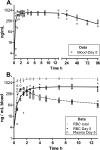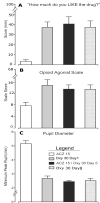A Pharmacokinetic Study Examining Acetazolamide as a Novel Adherence Marker for Clinical Trials
- PMID: 27300254
- PMCID: PMC5360176
- DOI: 10.1097/JCP.0000000000000529
A Pharmacokinetic Study Examining Acetazolamide as a Novel Adherence Marker for Clinical Trials
Abstract
Rationale: Accurate assessment of medication adherence is critical for determination of medication efficacy in clinical trials, but most current methods have significant limitations. This study tests a subtherapeutic (microdose) of acetazolamide as a medication ingestion marker because acetazolamide is rapidly absorbed and excreted without metabolism in urine and can be noninvasively sampled.
Methods: In a double-blind, placebo-controlled, residential study, 10 volunteers received 15 mg oral acetazolamide for 4 consecutive days. Acetazolamide pharmacokinetics were assessed on day 3, and its pharmacokinetic and pharmacodynamic interactions with a model medication (30 mg oxycodone) were examined on day 4. The rate of acetazolamide elimination into urine was followed for several days after dosing cessation.
Results: Erythrocyte sequestration (half-life = 50.2 ± 18.5 h, mean ± SD, n = 6), resulted in the acetazolamide microdose exhibiting a substantially longer plasma half-life (24.5 ± 5.6 hours, n = 10) than previously reported for therapeutic doses (3-6 hours). After cessation of dosing, the rate of urinary elimination decreased significantly (F3,23 = 247: P < 0.05, n = 6) in a predictable manner with low intersubject variability and a half-life of 16.1 ± 3.8 h (n = 10). For each of 4 consecutive mornings after dosing cessation, the rates of urinary acetazolamide elimination remained quantifiable.There was no overall effect of acetazolamide on the pharmacodynamics, Cmax, Tmax, or elimination half-life of the model medication tested. Acetazolamide may have modestly increased overall oxycodone exposure (20%, P < 0.05) compared with one of the 2 days when oxycodone was given alone, but there were no observed effects of acetazolamide on oxycodone pharmacodynamic responses.
Conclusions: Coformulation of a once-daily trial medication with an acetazolamide microdose may allow estimation of the last time of medication consumption for up to 96 hours postdose. Inclusion of acetazolamide may therefore provide an inexpensive new method to improve estimates of medication adherence in clinical trials.
Conflict of interest statement
For the remaining authors, no conflicts were declared.
Figures





References
-
- Fossler MJ. Patient adherence: Clinical pharmacology’s embarrassing relative. J Clin Pharmacol. 2015;55:365–367. - PubMed
-
- Blaschke TF, Osterberg L, Vrijens B, et al. Adherence to medications: insights arising from studies on the unreliable link between prescribed and actual drug dosing histories. Annu Rev Pharmacol Toxicol. 2012;52:275–301. - PubMed
MeSH terms
Substances
Grants and funding
LinkOut - more resources
Full Text Sources
Other Literature Sources
Miscellaneous

